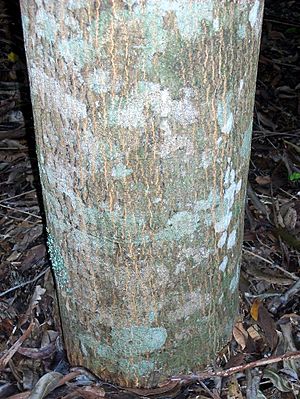Owenia cepiodora facts for kids
Quick facts for kids Owenia cepiodora |
|
|---|---|
 |
|
| Bog onion, trunk | |
| Scientific classification | |
| Genus: |
Owenia
|
| Species: |
cepiodora
|
The Owenia cepiodora is a medium to large tree found in the rainforests of north-eastern New South Wales and nearby areas in Queensland, Australia. It belongs to the plant family Meliaceae. People often call it the onion cedar, onionwood, or bog onion because its wood has a strong smell like onions.
This tree mostly grows in drier rainforests, especially where Hoop Pine trees are found, near the state border. In the past, many of these trees were cut down for their wood. Because of this, only small, new trees remain today. The Owenia cepiodora is now considered a vulnerable species, meaning it needs protection to survive. Its wood looks a lot like the valuable Australian Red Cedar. To get rid of the onion smell, people used to soak the logs in water before selling them as Red Cedar. You can find this tree as far south as the Richmond River and as far north as Canungra in the Gold Coast hinterland.
Contents
What the Onion Cedar Looks Like
The Owenia cepiodora can grow up to 30 meters (about 98 feet) tall. Its trunk can be as wide as 75 centimeters (about 30 inches). The top part of the tree, called the crown, looks dark and shiny green, similar to the Black Bean tree.
The trunk of the onion cedar is straight and round. It has brown bark with vertical cracks and lines. The smaller branches have marks where old leaves used to be. These branches are thick, smooth, and pale brown.
Leaves of the Tree
The leaves of the Owenia cepiodora are quite long, usually between 30 and 60 centimeters (about 12 to 24 inches). Each main leaf stem has 17 to 25 smaller leaflets attached to it. These leaflets are placed almost opposite each other. Interestingly, there is no leaflet at the very end of the main leaf stem.
Each leaflet is typically 7 to 14 centimeters (about 3 to 5.5 inches) long and 1.5 to 3.5 centimeters (about 0.6 to 1.4 inches) wide. They are shaped like a broad spear. The top side of the leaflets is glossy green, while the underside is paler and not as shiny. The main vein in the middle of the leaflet sticks out on both the top and bottom. Older leaves don't have a strong smell, but new leaves have a distinct garlic scent. The main leaf stalk is 20 to 30 centimeters (about 8 to 12 inches) long, and the small stalks holding each leaflet are 2 to 5 millimeters (about 0.08 to 0.2 inches) long.
Flowers, Fruit, and Life Cycle
White flowers grow on branching clusters called panicles. These flowers usually appear between November and December. Each flower has five petals, and they are about 4 millimeters (about 0.16 inches) long.
How the Tree Reproduces
The fruit of the Owenia cepiodora is a round, red drupe. A drupe is a type of fruit with a fleshy outer part and a hard pit inside, like a peach. This fruit has white pulp inside and is 1.5 to 2 centimeters (about 0.6 to 0.8 inches) wide. Each fruit usually has two, three, or four sections, and each section typically contains two seeds. The fruit ripens from January to March.
It can be tricky for new Owenia cepiodora trees to grow from seeds, as their regeneration is not always successful. However, when new trees do start to grow, it usually happens around November to January.

